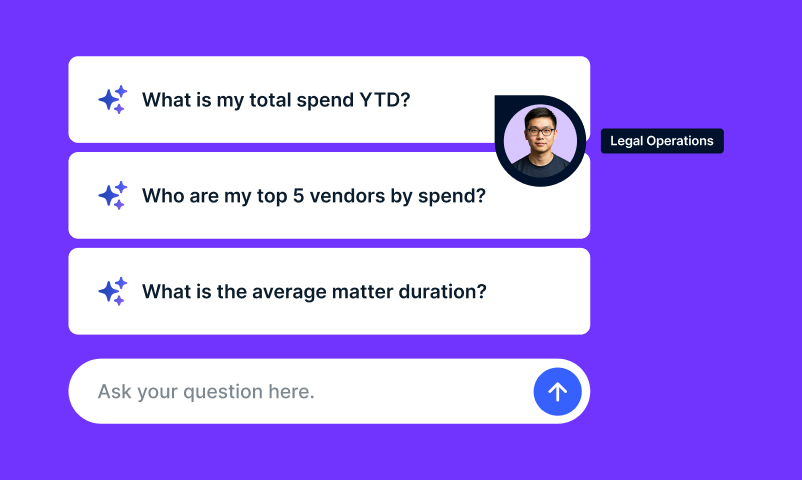
The pandemic changed everything about our world seemingly in the blink of an eye—corporate legal operations included. However, with change comes opportunity: to unlock novel technology solutions and discover cutting-edge ways of catapulting efficiency and catalyzing transformation for enterprise-wide excellence.
Consider these six corporate legal operations trends, compiled from the latest metrics and data, to tackle your ever-evolving law department challenges.
1. Turning Budgets into Roadmaps
Corporate legal departments are projected to triple their legal technology budgets by 2025, according to Gartner’s 2021 Legal Planning & Budgeting report. Additionally, the Corporate Legal Operations Consortium’s (CLOC) 2021 State of the Industry Report revealed that technology implementation is increasing, a triumph in efficiency for legal operations professionals who often tend to handle as many as five different business areas.
Not surprisingly, efficiency is the principal motivator encouraging general counsel (GC) and chief legal officers (CLOs) in $1B+ organizations to purchase new tech. With legal operations teams seeking to streamline and automate workflows, these purchases prove more than the sum of their parts. They are an integral part of “a defined and actionable legal systems roadmap,” the Association of Corporate Counsel (ACC) 2021 Legal Technology Report for In-House Counsel says. In fact, 32 percent of respondents in Deloitte’s 2021 State of Legal Operations Survey believe that procuring state-of-the-art e-signature, e-billing and contact management tools have supplied them with the ability to “provide actionable KPIs and reporting without significant manual effort,” maximizing time, energy and expenses saved.
2. Championing Diversity and Inclusion
Not only do diversity and inclusion (D&I) initiatives contribute to more robust work quality and skyrocket a competitive edge, they simply encapsulate the right thing to do. Still, despite an American Bar Association (ABA) ‘s Model Diversity Survey determining a marked leap in diversity among in-house counsel senior leadership, only 11.5% of GCs at Fortune 1000 companies were ethnic or racial minorities.
There is good news, though: post-pandemic, the number-one priority that legal operations professionals cite is implementing a D&I program.
Bloomberg’s 2021 Legal Operations Survey concluded that diversity is bolstered by both tracking metrics and introducing new processes, such as internal diversity training, more remote work opportunities and forward-thinking recruiting patterns. Also imperative? Holding vendors, namely law firms, responsible for the same standards of diversity and inclusion.
Three trailblazing companies that have elevated D&I are Intel, Uber and Novartis AG. Corporate legal departments can start by asking their current law firms to complete the ABA Model Diversity Survey and combining that data with D&I information from RFPs in a centralized legal solution.
3. Bridging Cybersecurity and Compliance Gaps
With data breaches on the inevitable rise and the average cost of a breach $4.24 million, it’s no wonder that 57% of the respondents in an ACC survey noted the urgency of having a “comprehensive data management strategy to ensure compliance, defensibility and security.”
Legal operations are an essential puzzle piece in comprehensive cybersecurity. Law.com stresses that organizations collaborate with IT to conduct data security and privacy measure audits focusing on consumer protection. The American Bar Association revealed that only 43% of those surveyed use encryption, and only 39% execute multi-factor authentication. Because remote work protocols dramatically augment technical vulnerabilities and cost over $1M more per breach, investing in a secure multi-factor authentication tool is fundamental for risk management.
4. Capturing the Power of AI
Artificial intelligence (AI) is no longer merely a visionary trick in sci-fi flicks: its tech has helped lawyers and legal operations professionals analyze data patterns and generate business insights.
AI has proven especially vital in legal contract review software by reviewing thousands of contracts simultaneously, migrating legacy contracts and exporting data in under five seconds. Studies show that its functional aptitude for performing first-pass reviews makes even the newest users more than 51% productive and 34% efficient.
Those percentages provide a compelling argument for AI when extrapolated across a legal department. Whereas an average company has 55 lawyers who review a total of 9,526 contracts annually, AI can propel the same legal team to process 4,906 more each year. That’s analogous to hiring 28 additional lawyers!
Another bonus? Saving in-house counsel countless hours while circumventing the 9.2% average value “leakage.”
5. Realizing the Win-Win of AFAs
Alternative fee arrangements (AFAs) have often been branded with a bad reputation. That’s likely due to many legal departments fearing they may pay more with an AFA than an hourly fee. However, the tide is slowly changing as the average amount of AFA revenue across AmLaw 200 firms has consistently increased since 2018.
However, AFAs –which offer benefits for spend management over traditional billable hours—can be incredibly advantageous for clients, legal operations teams and law firms. They provide more control over spend, more reliable billing and a greater capacity for companies to remain on budget.
Generally, the more flexible an AFA, the more appealing it is. Utilizing spend management software to analyze current AFAs and compare vendor rates can help make enterprise-changing decisions.
6. Navigating Data-Driven Vendor Processes
According to a survey of GCs, vendor management is their top priority. This is even though CLOC’s State of the Industry Report revealed only 27% of legal department respondents formally reviewed law firm performance. In such an absence of vendor evaluation guidelines, how can return on investment (ROI) be determined?
This is where legal technology software shines. By assisting legal operations teams in orchestrating a formal vendor performance review process, it can also track vendor metrics, billing compliance, accruals and spend totals, shifting to a data-driven strategy and the most cost-effective business resolutions.
Whether it’s accelerating staff, budget or technology, each of these legal operations trends shares one element: in today’s rapidly metamorphosing world, they are becoming more critical by the day. Embracing change and advancing unrivaled growth with enterprise legal management software, contract management and transformational vendor and diversity programs will revolutionize legal operations in 2022—and long into the future.
Read more about these top legal operations trends by downloading our latest white paper.











